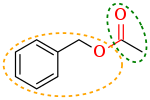Moiety (chemistry)
Appearance

In organic chemistry moiety (/ˈmɔɪəti/) is a term used for part of a molecule.[1] Larger moieties are often functional groups.[2]
A functional group is a moiety that participates in similar chemical reactions in most molecules that contain it.[3] In turn the parts of the group are termed moieties. For example, methyl p-hydroxybenzoate contains a phenol functional group within the acyl moiety, which in turn is part of the paraben moiety.
Moieties that are branches extending from the backbone of a hydrocarbon molecule, which can often be broken off and substituted with others, are called substituents or side chains.
See also
References
- ^ "moiety". IUPAC. Compendium of Chemical Terminology (the "Gold Book") (2 ed.). Blackwell Scientific Publications. 2014-02-24. doi:10.1351/goldbook.M03968. ISBN 0-9678550-9-8.
- ^ Mezey, P. G. (October 1996). "Functional Groups in Quantum Chemistry". Advances in Quantum Chemistry. 27: 165. ISBN 978-0-08-058252-8.
- ^ "functional group". IUPAC. Compendium of Chemical Terminology (the "Gold Book") (2 ed.). Blackwell Scientific Publications. 2014-02-24. doi:10.1351/goldbook.F02555. ISBN 0-9678550-9-8.
